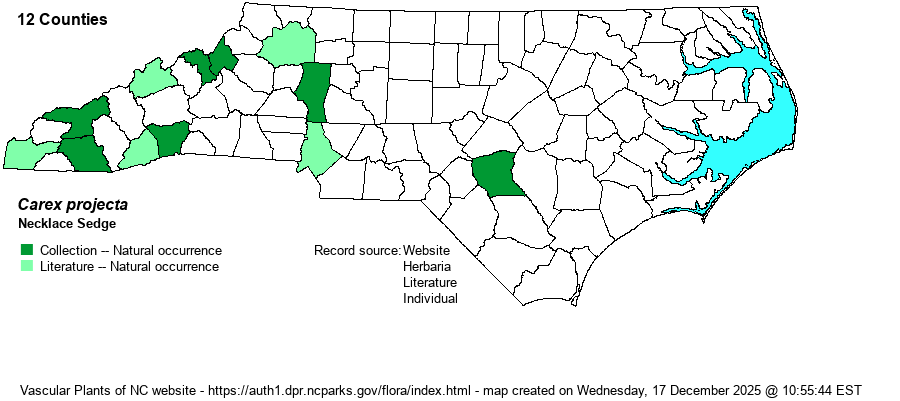| Author | Mackenzie | |
| Distribution | Scattered in the Mountains and upper Piedmont; disjunct to Cumberland County (specimens at NCU and FSU). Non-specimen records (pale green on the map) need identification check, as C. projecta is often hard to distinguish from C. normalis and others in section Ovales. For example, specimens were found for Lee and Cherokee counties, but both are misidentified. A specimen from Swain County, collected at 6200 feet, also needs an ID check. A specimen from Halifax County at COLO was annotated from C. tribuloides, but the original ID appears to be correct.
Lab. to Sask., south to SC, IN, and IA. | |
| Abundance | Rare, to perhaps locally uncommon; extremely rare east of Iredell County. The NCNHP database has 13-14 records, but only about 7 are considered extant. The website editors suggest a State Rank of S1S2, owing to a modest scattering of records across the western third of the state. It is considered as Significantly Rare by the NCNHP. | |
| Habitat | Moist depressions in mixed forests, streambanks, meadows, thickets. The habitats in NC are not well defined, but seem to cover a wide array of damp to wet sites, such that reasons for its scarcity are not obvious. | |
| Phenology | Flowering and fruiting May-June. | |
| Identification | Necklace Sedge is a member of section Ovales, so great care must be taken when identifying. Unlike many in the group, most perigynia of C. projecta stick outwards, creating a bristly appearance to the spikes but not as extreme as in C. cristatella. Female scales are evident in C. projecta and C. tribuloides, but hard to see in C. cristatella due to the large scales. From C. tribuloides, C. projecta can be told by its rather separated spikes in an inflorescence that leans over or arches (vs. crowded and erect in C. tribuloides). | |
| Taxonomic Comments | None
The genus Carex is the largest in North America, and among the largest in the world. In temperate and boreal regions, Carex is often the dominant or co-dominant ground layer in many habitats. Seeds (achenes) are valuable food for birds and small mammals, while foliage is used by birds and mammals to make nests and as food by mammals. Species of Carex often look vastly different from one another -- spikes erect vs. drooping, tiny inflorescence vs. whopping, culms leafy vs. naked, perigynia beaked vs. beakless, stems densely bunched vs. single, etc. The genus has been divided into many sections (or groups), based on shared characters; some taxonomists have suggested that these be different genera, but that proves unworkable (so far). All Carex share the feature of a perigynium (an outer covering) which completely surrounds the achene (seed). This covering may fit tightly or loosely (like a small bladder), depending on which group or species. Details of perigynia shape, ornamentation, presence and size of beak, number of striations (or veins) are all important ID features. In recent years Rob Naczi and colleagues have stressed the importance of arrangement of perigynia -- whether spiral (3+ ranks) or distichous (2-ranked) -- and have named a number of new species as well as split off some older synonyms. Therefore, RAB's (1968) key, excellent for its time, can only be used in a general way today. Members of some sections of Carex are difficult to key out (notably Ovales, Laxiflorae, Griseae); this is in part due to variation among individuals of a species, or failings of the key. FNA has drawings of most species and some species may be found in two or more places within a key, to acount for variability. New species to NC, and new to science(!), continue to be found in NC. | |
| Other Common Name(s) | Loose-headed Oval Sedge | |
| State Rank | S1 [S1S2] | |
| Global Rank | G5 | |
| State Status | SR-P | |
| US Status | | |
| USACE-agcp | FACW link |
| USACE-emp | FACW link |

